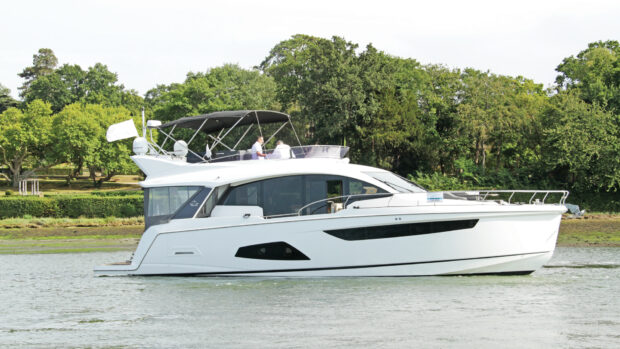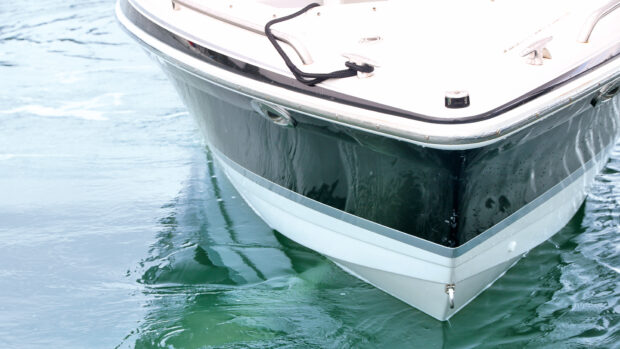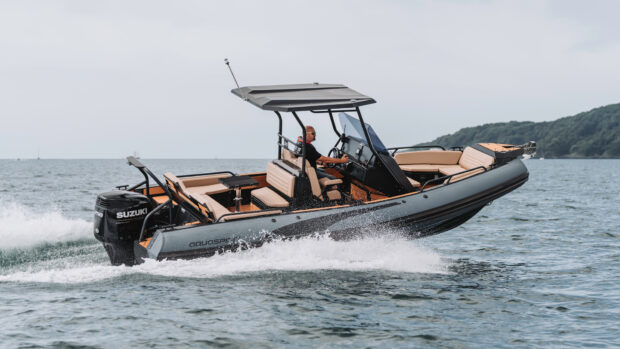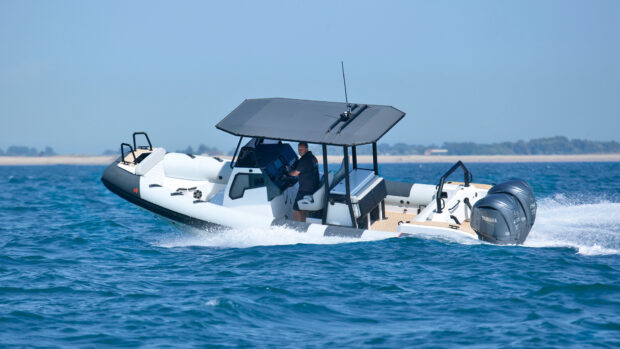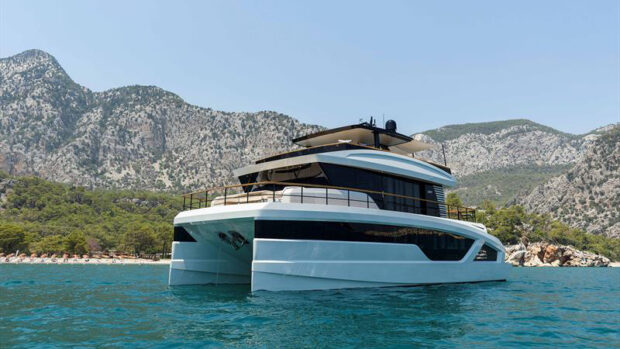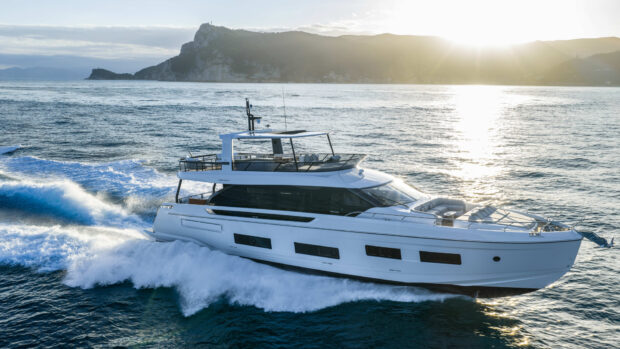The Aiata Wayfinder 38, which aims to be a something of a Swiss Army Knife in the motor boat world, impressed us when it was launched. How will it stand up in our full sea trial?
Very few fledgling boat builders have excited the public imagination to the same degree as Aiata. We first witnessed this new Turkish brand at its world launch at the Düsseldorf Boat Show, where it tried to illustrate what it called the “game-changing” versatility of its modular build approach by exhibiting three versions of the new Aiata Wayfinder 38.
It was certainly clear that the ability to swap furniture units in and out was a great way to help optimise the base platform in favour of seating, dining or fishing – but the key selling point for most of us was the ability to buy it as an open boat with a T-top before adding rear and side doors at a later date and turning it into a fully enclosed Cabin model further.
If that sounds like a slightly fraught concept, replete with teething troubles and longevity concerns, what was equally clear in Düsseldorf was how slick and cleanly resolved these boats were.
We’ve seen a great many prototypes over the years but few, if any, have felt quite as polished as this, and that actually makes more sense than it might seem. After all, Aiata is owned by the Anadolu Group, a multi-billion-dollar conglomerate and a major driving force in the Turkish economy.
Long before the show began, it had already solicited the award-winning Nordic design agency co-founded by Jarkko Jämsén, famous for his work with Axopar, to design its new range.
It had already executed a head-hunting campaign, recruiting some of the industry’s most capable professionals from some of the world’s most stellar brands. And it had already invested €15m in the creation of a highly mechanised, automotive-style 20,000sqm manufacturing plant in Çayırova, Turkey, without any immediate expectation (or need) for a profit.
In short, the new and previously unseen Aiata Wayfinder 38 looked absolutely packed full of merit, so when we received an invitation to enjoy a closer look and a sea trial in Istanbul, it was not an opportunity we were likely to pass up.
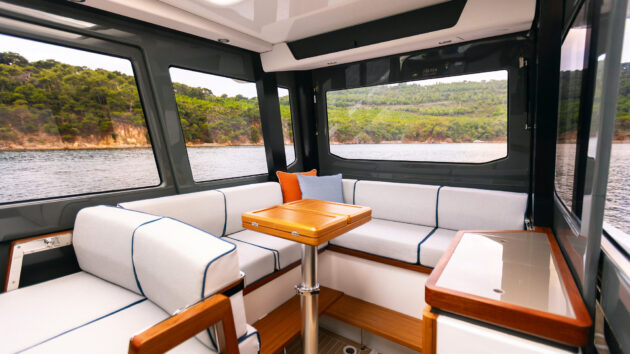
The rear window swings up allowing the reversible aft bench to face out into the cockpit
Clever aft cockpit
The long-term ethos at Aiata is to deliver high-powered, modular, multipurpose vessels that prioritise comfort and ease of use – and a symmetrical walkaround layout is a great way to go about that.
What we have on the Aiata Wayfinder 38 is a central pilothouse, evenly sized side decks, a short aft cockpit and a remarkably beamy bow that extends the deck space in virtually unbroken rectangular fashion with a wildly prodigious bow flare that has more than a little of the platypus aesthetic about it.
But before we get to that, it’s interesting to see how Aiata has mitigated the modest footprint of the aft cockpit with some really fresh and unusual features.
For a start, the excellent two-part side gates provide much wider openings in the bulwarks than most, which makes them far better for loading and unloading bulky baggage from the pontoon, as well as for swimming, watersports or simply sitting side-by-side with your partner, dangling your feet in the water.
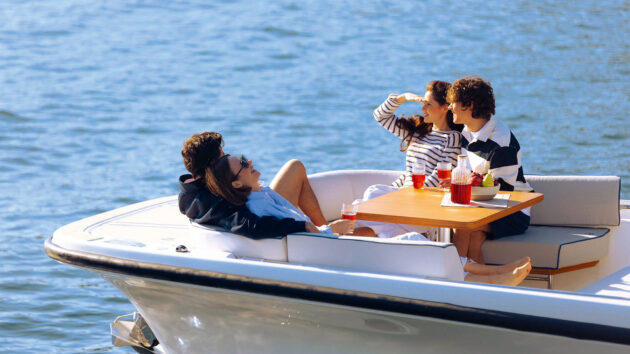
The squared off bow can seat up to eight
To see them at their best, you do need to spec the optional carbon fibre ladder, which is around €4,000, but if you baulk at that price, you won’t once you see what it buys you.
Moulded from carbon fibre, the ladder is so exquisitely crafted that you would happily mount it on your dining table, let alone your boat. And it’s practical too, thanks to a pair of swivelling brackets at the top end that enable you to lie it dead flat in even the shallowest locker.
As for the rest of the cockpit, the test Aiata Wayfinder 38 comes with nothing more than an aft bench that faces forward toward the pilothouse via an optional transverse table. But if you swing up the aft bulkhead on strong rams and reverse the backrest of the internal bench, that faces aft to create a very serviceable dining station for six.
This ‘internal’ bench is far more elevated than the external one, so a hatch drops down to create a footrest for those facing aft. And that in turn reveals a storage trough for lifejackets, as well as a very natural spot for an additional fridge. But as mentioned, it’s the modularity that really hits home…
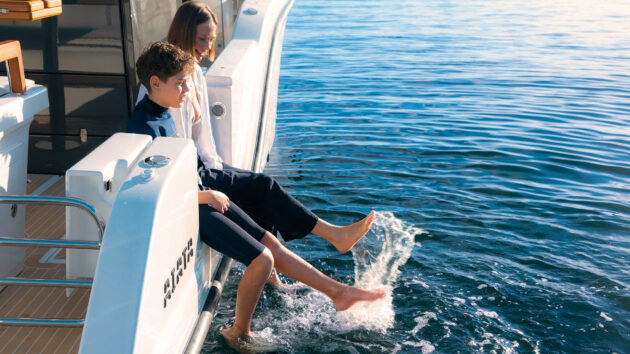
The two-part side gates are wide enough for a couple of people
For instance, you can trade the Aiata Wayfinder 38 cockpit’s aft bench for a fishing station or, better still, for what Aiata calls the Comfort Wet Bar. In spite of the fact that it adds more than €11,000 to the package price, this wet bar module provides not just cooking, refrigeration and storage facilities but also a high-level bench seat when the wet bar is not in use.
That sits at much the same level as the raised aft-facing bench that looks out from the internal saloon, creating a much more natural dining set-up than the test boat’s staggered heights.
The fact that you can’t leave the swing-up aft bulkhead open underway is a shame because facing aft from the comfort of a bench within the protective structure of the pilothouse would be a very attractive thing. But this remains a really rewarding way to manage such a compact outdoor space.
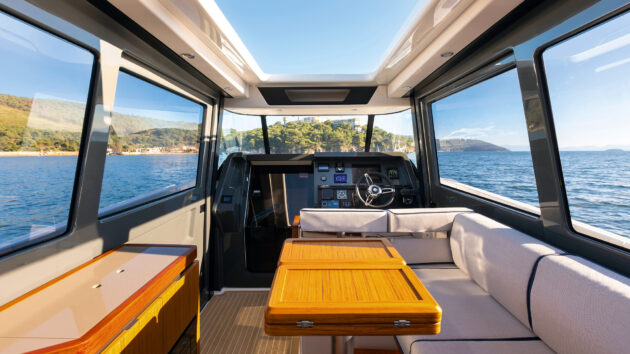
The dinette makes best use of space with reversible benches both fore and aft
Enormous bow lounge
As you make your way forward, the attention to detail is really strong. Extraordinarily deep bulwarks come up above the waist amidships for outstanding security, but there are also integrated bulwark steps, as well as tread plates machined into the gunwales, for easy access to the rooftop and to the pontoon.
There are beautifully lined under-deck storage spaces all over this boat and the finishing is good too. You can rummage about in all kinds of hidden crevices, safe in the knowledge you won’t slice your hands on shards of unfinished fibreglass. And when you reach that flamboyantly expansive bow, there’s plenty of space for up to eight people around a high-low table that enables you to rig a forward sunbed without obstructing the walkaround decks.
You do need to spec the extra lateral seats to turn the standard bow bench into a U-shaped unit and that adds another €4,420 to the bill, but it feels like a very worthwhile investment and again, the finer details are really striking.
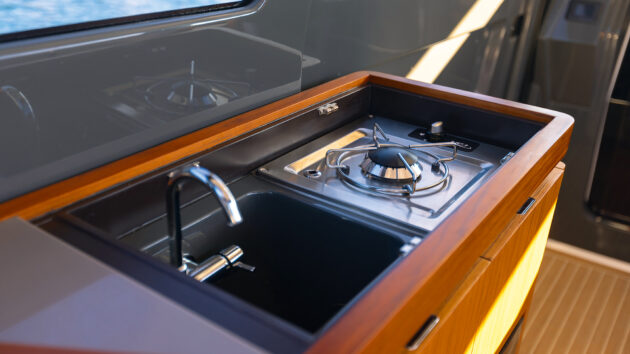
The ‘galley’ is best supplemented with the external wet bar
There’s a cushion cut-out in the bow bench for an inset window, which admits extra light down below; and in a stroke of design excellence, the infills for the bow sunbed can also be used in the pilothouse’s convertible dinette, before slotting neatly into place as the bedhead for the double berth when not required elsewhere.
In fact, even the bow locker on the Aiata Wayfinder 38 gives you a warm feeling inside. By locating the anchor chain in a sunken recess behind that broad forepeak, the designers have freed up plenty of space in the main cabinet for a whole load of fenders, as well as for a dedicated cylinder on the port side, which keeps the LPG bottle safe and ventilated, well out of harm’s way.
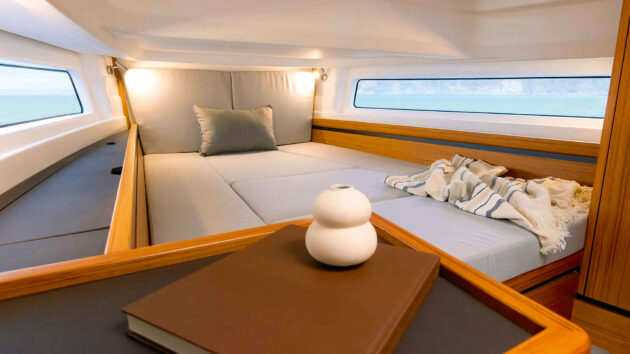
: There’s only one cabin but it’s bright, beamy and nicely put together
Spatial compromises
In spite of the fact that we have such a big bow space and such generous walkaround decks on both sides, the internal dinette is actually pretty big – and the reason for that, of course, is that it cheats. As noted, at the aft end, that swing-over backrest has enabled the designers to shorten up the aft cockpit without impoverishing its practicality.
And at the forward end, the two-man bench uses another swing-over backrest, this time to steal the space that would otherwise be dedicated to the skipper and co-pilot. It’s a clever way to arrange the space and it’s practical too, thanks to under-seat storage, more comfy footbraces and a very handy storage slot above the screen in the front end of the roof moulding.
Given how much space this swallows up, you wouldn’t expect the port galley to be the star of the show and it isn’t. It’s compact and tapered in order to keep movement free and easy and that means it’s limited to nothing more than a single gas ring, a small sink and an optional microwave.
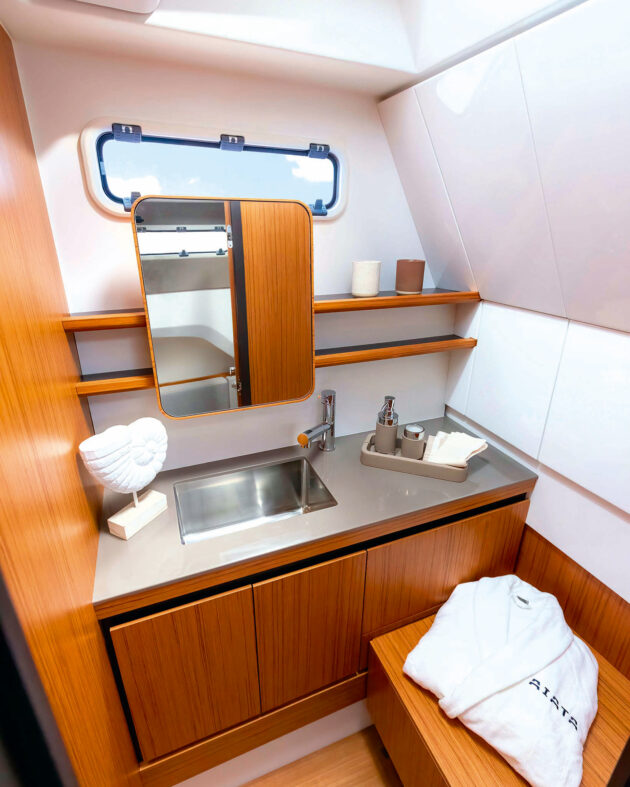
The wetroom gets masses of light from a skylight panel mounted in the dash
The fridge meanwhile has to be exiled to the cavity beneath the helm bench so if you like the idea of this Cabin model, the transom Wet Bar we talked about earlier is likely to feel worthwhile in more ways than just one.
Down below on the Aiata Wayfinder 38, the bow cabin features a changing seat on the portside that extends aft beneath the saloon deck, creating a handy storage slot (or an oddly practical single bed). And such is the beam-forward design of this boat that the Queen-size double berth enables you to sleep with your head forward, as well as aft.
On the starboard side, a hanging locker backs onto a separate wetroom-style bathroom with 2m of headroom and plenty of light, thanks to a large glass panel built into the dashtop. And while it’s plain that the upper deck has been given priority, the capacity to sleep three people down below and two up top, as well as to operate all year round, makes the Wayfinder 38 much more than just a dayboat.
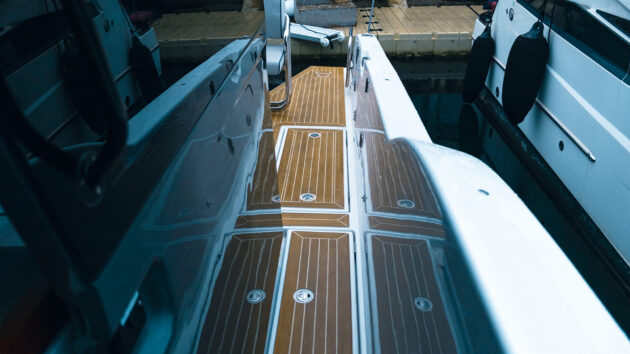
There are cleanly lined underdeck storage spaces all over this boat
Swift but steady
When you get underway, this boat does err more on the side of weighty and mature than vigorous and dynamic. Accelerating onto the plane and through the rev bands, for instance, is quite a stately undertaking. With six people on board and a full tank of fuel, our twin 350s push on with obedience rather than aggression – and that maturity is matched by the handling.
With that fine entry and big bow flare, it feels as soft and dry in moderate seas as you would expect and what’s also notable is how little it appears to get bullied by the wind. Even with the tabs on manual and a Force 3 on the beam, very little input is needed to keep this boat flat. And when you heel it into a fast turn, it again puts in a remarkably composed performance – particularly for a boat with a twin-stepped hull.
When we do throttle on, we eventually see 45.5 knots, which is quick enough for most, but for our money, a pair of Mercury 400s would still be worth looking into. As for cruising range, that looks best at between 30 and 36 knots – and although this is not an especially quiet boat, comfort is strong.
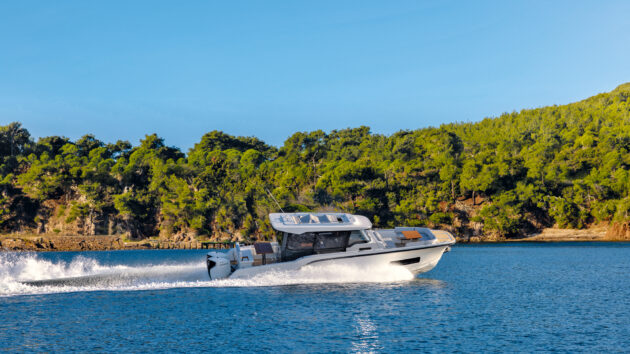
Everything experimental has been addressed and finessed
The raised helm seat provides great visibility over that elevated dash, and the steep screen, fine mullions and deep side windows certainly help with that. The adjustable wheel is matched by lots of travel on the seat, and critical stuff like the bow thruster, sliding side doors and deep, safe side decks, come as standard.
There’s no inboard option because, as a worldly commercial power, Aiata has paid close attention to market trends. But even as a stepped hull with a pair of beefy outboards, it could hardly be more user-friendly than this.
Aiata Wayfinder 38 specifications
LOA: 38ft 0in (11.57m)
BEAM: 11ft 6in (3.49m)
DRAFT: 2ft 1in (0.64m)
DISPLACEMENT: 2,500kg (light)
FUEL CAPACITY: 850 litres
WATER CAPACITY: 200 litres
ENGINES: 1-2 outboards from 300-425hp
RCD: C10
CONTACT: www.aiataboats.com
Aiata Wayfinder 38 costs and options
From €360,000 ex VAT Test boat includes the following options…
Seakeeper: €25,821
Genset: €10,850
Aft table: €3,627
Lateral bow seats: €4,420
Retractable roof: €6,232
 If you enjoyed this….
If you enjoyed this….
Motor Boat & Yachting is the world’s leading magazine for Motoryacht enthusiasts. Every month we have inspirational adventures and practical features to help you realise your sailing dreams, as well as tests and news of all the latest motorboats.
Plus you’ll get our quarterly Custom Yachting supplement where we share the last on offer in the superyacht world and at the luxury end of the market.
Build your knowledge with a subscription delivered to your door. See our latest offers and save at least 30% off the cover price.
Note: We may earn a commission when you buy through links on our site, at no extra cost to you. This doesn’t affect our editorial independence.
Verdict
This is how a debut boat ought to be done. Everything speculative or experimental has been addressed and finessed by a cherry-picked team, backed up by the kind of industrial know-how and financial might most boat builders can only dream of. The result is a beautifully designed, beautifully built and highly versatile family platform that sidesteps the most competitive sectors of the market by simple virtue of being different. You might well question the beauty of that ungainly ‘platypus’ bow, that hinged aft bulkhead or a two-berth cuddy-style set-up on a beamy 38ft pilothouse cruiser. But if style and accommodation are not the chief priorities for you, this is a barnstorming boat at a price significantly more accessible than its calibre suggests.
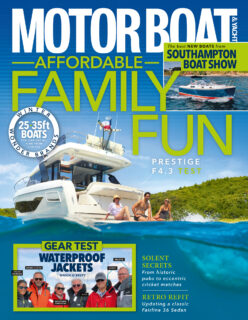


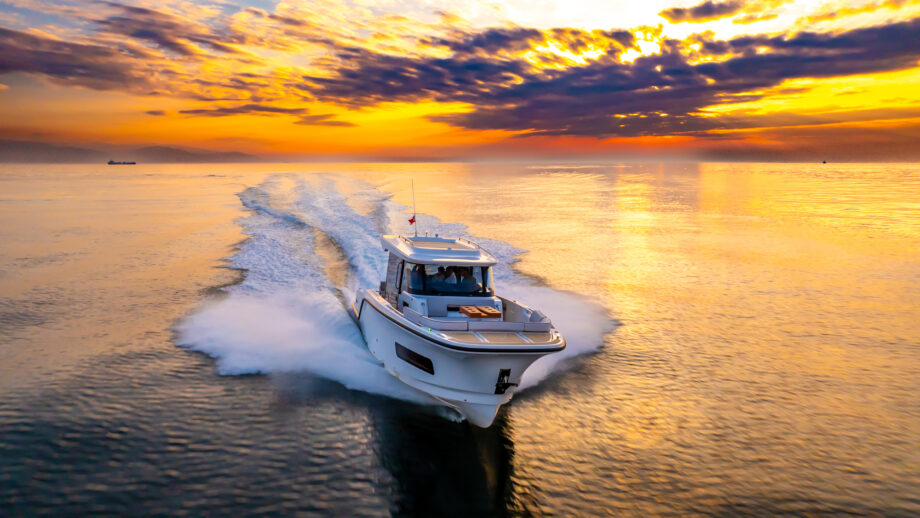
 If you enjoyed this….
If you enjoyed this….